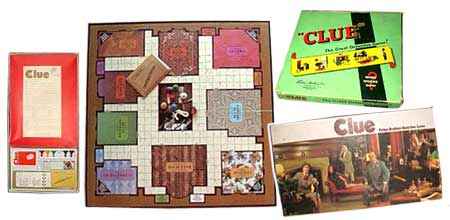Clue

Synopsis of Toy
Tired of Monopoly’s property-buying frenzy? Leery of Life’s arbitrary wheel of travail and triumph? Come sit Indian style on the shag carpet and play a game of Clue with us. It’s fairly quick, it’s not easy enough to feel insulting, and best of all, it’s downright sordid!
The board game’s inventor was a British law clerk named Anthony Pratt, who dreamt it up circa 1947, while walking his beat as a wartime fire warden in Leeds. When the bombs weren't dropping, social sets used to gather in one another’s homes for a parlor game called “Murder,” in which guests would creep around and simulate the murder of one of their own. That was the seed, and Pratt came up with rest.
Profits from the popular game allowed Pratt to become a pianist, his longtime dream. But just like the mysteries that his game hinges on, Pratt fell out of sight late in the twentieth century. In 1994, Waddington’s Games, the present day owners of Cluedo (which is what the game is called in the U.K.), tried to track Pratt down to celebrate the game’s 50th anniversary. They didn’t have a clue where to look until a cemetery official in central England used a special investigation hotline number and told Waddington’s officials that there was one Anthony Pratt buried there a few years prior. His tombstone read “Inventor of Cluedo.” Case closed.
In the mid 1950’s, Pratt sold his game’s rights to Waddington’s. In the U.S., the game was marketed by Parker Brothers, now under the Hasbro umbrella. The game has sold over a hundred and fifty million copies and still lurks in the Top-10 of annual board game sales. It has inspired a rompy spin-off film in 1985 (made with three different endings), a popular CD-ROM, and has led probably not a few players to consider a career in the detective arts.
To play Clue, you needed only to know a bit about the malfeasance. When a handful of guests gathered at a Victorian mansion, their host, poor Mr. Boddy, was murdered. There were six suspects (Professor Plum, Mrs. Peacock, Miss Scarlet, Mrs. White, Mr. Green, Colonel Mustard), six murder weapons (lead pipe, wrench, knife, rope, candlestick, revolver), nine rooms and 324 possible combinations of the crime. Cards which designated a murderer, a weapon, or a crime scene location were secretly selected at the top of the game, and placed in the ‘Murder Envelope.’
The rest of the cards were divided up, each player chose a suspect to “be,” then rolled the dice to move through the mansion. Upon entering a room, the player made “suggestions” as to the murder scenario, and if they held any of the suggested information, other players revealed their cards—to the interrogator only. Players noted the results of their Q&A on their handy detective notepads, making very sure no one stole a glance at their deductions. And if someone cared to throw other players off the truth’s scent, he could misdirect the poor devils by suggesting scenarios only he knew to be impossible.
When a player finally felt confident solving the whodunit, he jotted down his guess and took a private look at the murder envelope’s contents. If he was wrong, the game was over for him, and the other suspects carried on. If he was right, he wore the crown of ‘Super Sleuth’—at least until the next game.
Though Clue players have never known why Mr. Boddy was killed (the villain’s “motivation,” in sleuth parlance), everyone in the mansion looked very suspicious indeed. Ms. Scarlet was the vampy femme fatale, Colonel Mustard was huffy and monocled, Mrs. White was the resident maid—so it’s possible she was just fed up with her vocational choice, Professor Plum looked dangerously booksmart, Mrs. Peacock looked dangerously snooty and Mr. Green, well, girl players always had crushes on Mr. Green, and though he looked too cute to do something as dastardly as commit murder, one just never knew.
Playing Clue was a cutthroat business (perhaps literally, if the knife was the weapon of choice), and it remains so more than 50 years after the game's invention. It takes high-rolling and good interrogation skills, and if you’re especially savvy, maybe a little reverse psychology. Of course, for the dirty players out there it was always easier just to distract everyone while getting a sneak peak at the cards before they made their way in the sealed envelope. Get thee to Boddy’s mansion, you amateur sleuths—go fight the good detective fight.
Release History of Toy
1947 - Cluedo is inventedmid 1950's - Cludedo, re-named Clue, comes to America
Sub Categories of Toys
gamesboard games
